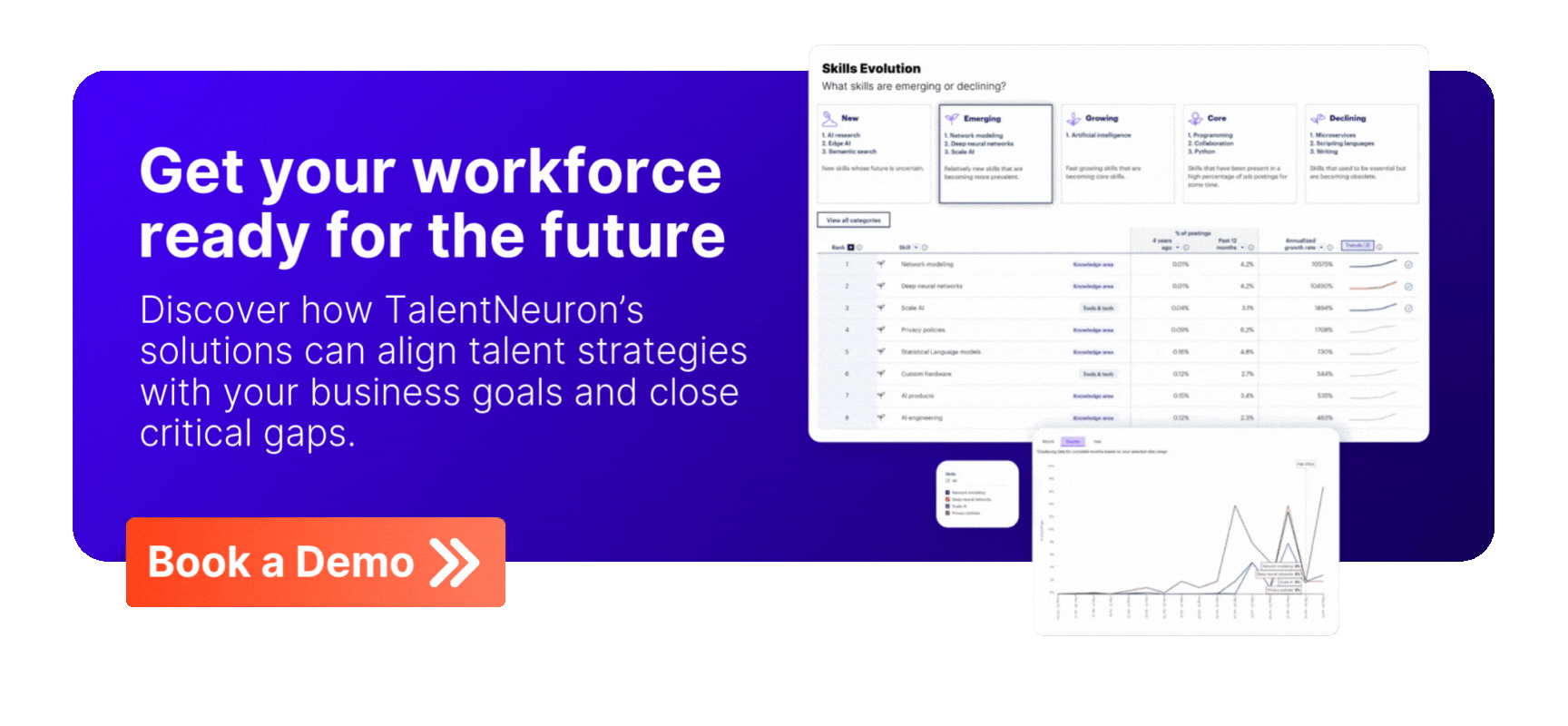Data-Driven Talent: The Competitive Intelligence Edge
.svg)
Data-Driven Talent: The Competitive Intelligence Edge
How AI-powered insights deliver a measurable advantage in talent strategy and skills-based hiring
.png)
Today's labor market volatility is a top business risk. Competitors are no longer just rivals for market share; they are direct threats to your human capital — the core engine of innovation and growth.
To secure long-term success, organizations can't rely solely on static strategies. They require real-time, data-driven competitive intelligence (CI) that quantifies how rivals are attracting, retaining, and investing in mission-critical skills. CI is the essential compass that guides proactive workforce transformation, ensuring you build a future-ready workforce and mitigate your financial exposure to talent gaps.

Competitive Intelligence as a Core Business Strategy
Competitive intelligence is the systematic application of external data to inform critical business and talent decisions. For executive leaders, it is the key engine for strategic talent planning, risk mitigation, and investment benchmarking. By operationalizing CI, the organization can analyze, track, and anticipate the actions of talent competition, directly improving talent strategy and securing key human capital.
While CI provides tactical optimization for operational teams, for the C-suite, a robust CI tool delivers crucial answers that link talent to the balance sheet:
- Which regional or functional rivals are directly threatening our innovation pipeline?
- Where are we exposed to talent churn in critical, high-value skill areas?
- What major competitor hiring patterns signal their next strategic market move?
Talent competitors vs. business rivals: A financial distinction
A critical distinction for modern talent strategy is recognizing that not all threats are equal.
If a high-growth tech firm outside your industry is hiring the same specialized data science skills, for example, they are a direct and quantifiable threat to your ability to innovate — making them a crucial talent competitor regardless of their product portfolio.
CI is Fundamental to Skills-Based Strategy and Future-Proofing
Organizations leverage competitive intelligence to proactively shape their workforces and secure future growth, particularly by moving to a skills-based approach. Here's where CI becomes a business imperative:
De-risking the future workforce
CI is the primary mechanism for future-proofing the workforce. By analyzing competitor activity, competitive intelligence tools act as predictive instruments, anticipating where industry leaders are placing their next significant skill investments. This ensures your talent strategy prioritizes future-oriented, high-value skill clusters and avoids costly investments in obsolete capabilities.
Strategic role benchmarking and investment
CI enables organizations to benchmark their talent needs against those of market leaders. This is achieved by quantifying the gap between the skills your organization requires versus what the leading talent competition is actively seeking. Benchmarking ensures that your job profiles and compensation are optimized for attracting top-tier talent, allowing you to strategically place talent investments in alignment with crucial market demand.
Informing capital allocation with competitor data
CI utilizes real-time competitor hiring data — including skills demanded and location information — to provide data-backed insights into market density and resource allocation. This analysis informs whether a labor market is saturated or untapped, directly guiding the decision to allocate resources or execute a strategic pivot to an alternative, more promising talent market.
The Mandate for Data-Driven Competitive Intelligence
Operating without robust, data-driven competitive intelligence tools is a strategic liability. Organizations risk operating with "market blind spots" by ignoring competitors' evolving talent models. This reactive stance leads to serious consequences for the balance sheet: high talent churn, costly mis-hires, and the inability to attract the specialized talent required for innovation.
To mitigate these risks, executive teams must mandate solutions that move beyond static, descriptive data (what happened) to provide prescriptive guidance (what should happen).
Leveraging AI-powered insights for prescriptive action
The shift to a prescriptive talent strategy is enabled by AI-powered insights. Modern CI solutions rely on:
- Global labor market intelligence: Access to real-time, global data ensures your talent strategy remains agile and ahead of the curve, minimizing market risk.
- AI-powered analysis: Machine learning algorithms process millions of data points, identifying subtle, financially relevant shifts in competitor behavior — a critical advantage for driving smarter, proactive talent investments.
This combination allows organizations to accurately anticipate market moves and make proactive strategic decisions, strengthening their core competitive edge.
Gaining a Measurable Advantage Through Real-Time Intelligence
Real-time global labor market intelligence provides three powerful levers for securing a measurable, competitive advantage:
1. Close strategic skill gaps
Competitive intelligence reveals which skills are emerging (high-growth potential) versus those that are declining (obsolescence risk). By quantifying the gaps between your organization's priorities and those of your talent competition, you gain the intelligence needed to proactively launch targeted reskilling programs and strategically future-proof your workforce.
2. Benchmark the employee value proposition (EVP) as a retention tool
Using CI for EVP strategy allows leadership to assess their and their competitors' strategic advantages. By tracking employee sentiment through reviews and ratings, companies quantify how their culture, compensation, and EVP compare. This intelligence enables leaders to:
- Craft a compelling employer branding narrative that highlights true strengths.
- Proactively address internal concerns revealed through sentiment analysis.
- Actively reduce the financial risk of losing top talent by offering a demonstrably superior value proposition.
3. Inform strategic investment and location pivots
Gaining granular insights into competitor hiring activities allows for strategic adjustments to capital and resource deployment:
- Location strategy and sourcing: CI determines precisely where rivals are sourcing talent. This analysis reveals strategic, untapped locations, allowing the business to expand its talent footprint efficiently while lowering labor costs.
- Anticipating market shifts: Tracking where competitors are ramping up hiring signals potential market expansion or significant investment in new product lines. This allows the executive team to adjust its talent strategy to preemptively secure talent, directly impacting the speed of market entry.





